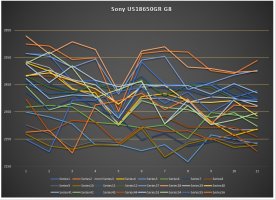BlueSwordM
Member
- Joined
- Jul 5, 2017
- Messages
- 423
It takes a bit of time and more cycles for internal resistance to fall off a cliff.

BlueSwordM said:It takes a bit of time and more cycles for internal resistance to fall off a cliff.

Overmind said:Interesting find. It kind of matches my own results. Let me tell you my experience with green Sony cells.
If anyone is interested, I'll post a picture with the complete table of all brands, since I recently tested over 600 cells in total (power tools brands included).

Overmind said:@Wolf they were stored at full charge. Most of them had above 4.10 V when rested for capacity, but they were recharged at least once per year.
Wolf said:The 0V cells where slow charged with CC/CV for 48 hrs and never recovered they got up to about 1V and as soon as they were removed their V dropped down to next to nothing. I determined these were dead.
DCkiwi said:that was most likely a problem with unsupervised ..........or more specifically not removing the failed cell/s to let the rest continue............
FYI also, I have found a thermal imager to be extremely...................
of course ... all four might be bad, but I would happily bet against that. loving your data Wolf... legend!
Not really sure. Could be temp related but house temps don't really change much.The cat could be sleeping on them or the dog panting waiting for the results.Chablis_m said:Those clusters of 4 reds are strange
When 1 cell goes red so do the other three in the tester
Any idea why?










